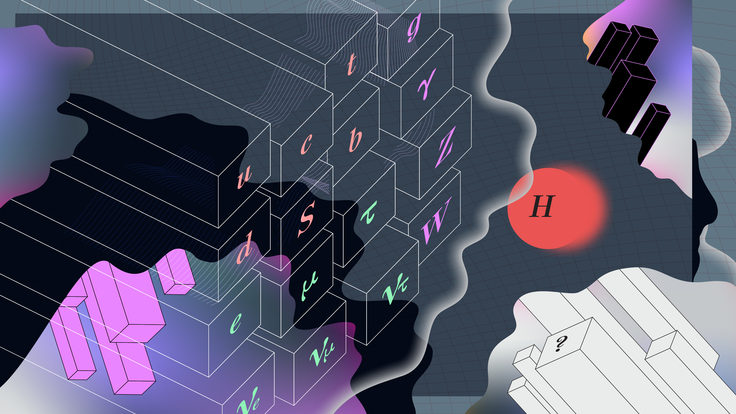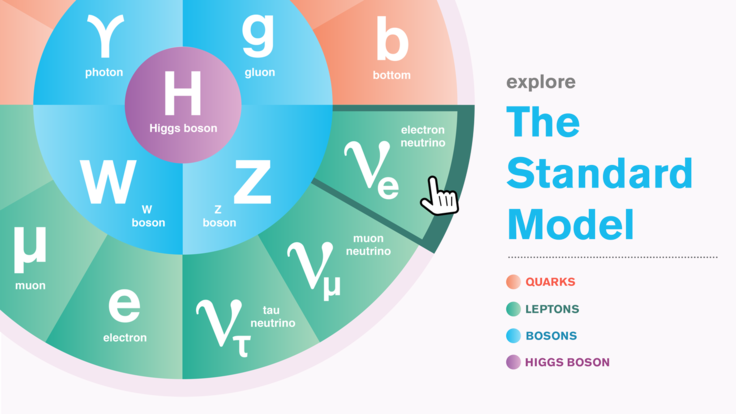In 1964, the same year the Beatles rocked their way into the hearts of Americans on The Ed Sullivan Show, British theoretical physicist Peter Higgs and five of his colleagues proposed a solution to a lingering mystery within the Standard Model of physics.
In 2012, after an almost five-decade-long search, the ATLAS and CMS experiments at the Large Hadron Collider at CERN near Geneva, Switzerland confirmed the long-standing theory when they observed a new particle: the Higgs boson.
Physicists have continued to study the Higgs at the LHC, investigating its properties and interactions with different particles. But the LHC is a discovery machine, made to concentrate great amounts of energy into small points of collision in order to produce a wide variety of particles. To really study the newest fundamental particle, physicists have plans to build a new collider, perfectly tuned to mass-produce Higgs bosons.
Over the past few years, the US high-energy physics community came together to give their input into a strategy for the upcoming future of the particle physics program. The result of that long process was a report by the Particle Physics Project Prioritization Panel, or P5, approved by the High Energy Physics Advisory Panel in December 2023. One of the report’s top recommendations is to continue research and development into a Higgs factory to further study the Higgs boson.
“Now that we have the Higgs boson from the LHC, we have a complete Standard Model to our current knowledge,” says Julia Gonski, an early-career scientist at the US Department of Energy’s SLAC National Accelerator Laboratory who took part in the community planning process that led up to P5, and a researcher on the ATLAS experiment at the LHC. “Now it’s time to go back and study the Higgs carefully, and the technological readiness is almost there.”

A targeted factory
Although the LHC successfully observed the Higgs boson, the collider has some limitations when it comes to researching the particle, says Robert Zwaska, an accelerator physicist and particle physicist at Fermi National Accelerator Laboratory and a member of P5.
As illustrated in Albert Einstein’s famous equation, E=mc2, energy and mass are two forms of the same thing. The LHC collides beams of particles, converting energy into mass, which creates other short-lived particles that decay into lighter particles, such as electrons and neutrinos, and energy.
The energy in the LHC comes from the collisions of composite particles such as protons, which are collections of quarks and gluons.
Each collision is actually an interaction between a piece of one proton and a piece of another, each piece containing a fraction of the proton’s full energy. For that reason, collisions involve wildly varying amounts of energy and produce wildly varying types of particles.
“In a proton collider, the energy has to go into a lot of different constituents,” Zwaska says. “You can't just take all the energy, and then have it come out exactly as what you want. It creates a lot of other particles at the same time.”
A Higgs factory, on the other hand, is designed to produce cleaner, more uniform collisions with just the right amount of energy to kick out Higgs bosons.
“There are a few ways to do this, but it’s most likely going to be through colliding an electron and positron,” Zwaska says.
Electrons and positrons, unlike protons, are fundamental particles; they’re not made up of anything else. The appealing thing about colliding fundamental particles, Zwaska says, is that all the energy within them goes into the collision.
A specialty machine will allow scientists to focus on the interactions they are aiming for, which will improve the reliability and breadth of data that comes out of the collisions.
“We want to measure every parameter of an interaction with extreme precision, first because that gives us a better understanding of the Standard Model,” says Gonski. “And second, if there are any deviations between theoretical expectation and what we actually measure, that can be a hint of where we may be able to look for new physics.”
Linear or circular
The P5 report supports consideration of two current candidates for a Higgs factory: the proposed International Linear Collider—the ILC—in Japan, and the proposed Future Circular Collider—the FCC—at CERN. Physicists have also proposed building a Higgs factory called the Circular Electron Positron Collider—CEPC—in China.
As their names suggest, the International Linear Collider is a straight, linear collider, while the Future Circular Collider is an enormous circle. Both options would use superconducting radio-frequency cavities to accelerate and collide electrons and positrons, but the different architectures of the two proposed colliders would affect the type of information scientists could gather.
In the ILC, beams of particles would travel from each side of the linear collider and meet in the center. In the FCC, beams of particles would accelerate in opposite directions around a circular path and pass through one another at specific collision points, like they do in the LHC.
“From an experimental point of view, the difference is that what comes out of the ILC is somewhat pulsed, because of the delay between acceleration bursts,” Zwaska says. “Whereas in the FCC, the beams are constantly counter-rotating and colliding with each other, so the collision rate is consistent for hopefully hours, or days.”
Another major difference, he says, is in how the beams collide. In a linear collider, beams are launched from locations tens of kilometers apart, and must get to the same location within nanometers. “It’s incredibly challenging, and there has been only one linear collider in history,” he says. “In a circular collider you can finely adjust the beams to get very stable collisions, because the beams repeatedly pass through the same magnets.”
The data the two colliders would produce for precision Higgs studies would be very similar, Gonski says. “It’s really just different ways to go about achieving our goals for characterizing and understanding the Higgs.”
The head of the P5 panel, theorist Hitoshi Murayama, calls the ILC “shovel-ready and technologically mature.” But to move forward with construction, scientists still need to gain the approval of the Japanese Ministry of Education, Culture, Sports, Science and Technology, something they’ve been working on for a little over a decade.
Conceptual studies for the FCC began in 2014 with a design report delivered in 2019. CERN is scheduled to complete the remaining feasibility studies in 2025.
In April, representatives of the United States government and CERN issued a joint statement of intent to continue working together toward the development of the FCC. Should the CERN member states approve the plan for the European research center to move ahead with construction, the US will collaborate.
A global endeavor
The US particle physics community will certainly be involved no matter which option prevails, Zwaska says. “There are many ways the US could participate—in terms of technology, physics, design—so we’ll definitely be part of that. In terms of a more formal approach, we’re still waiting on that.”
The High Energy Physics Advisory Panel, the group that approved the P5 report, is a government panel that advises DOE and the National Science Foundation on particle physics efforts. In May, members of HEPAP received reports from a HEPAP subpanel focused on studying the feasibility and scientific importance of proposed facilities for high-energy physics including the ILC and FCC.
“A Higgs factory is absolutely central because it will address many of the scientific priorities that P5 laid out for the field,” says Natalie Roe, associate laboratory director at Lawrence Berkeley National Laboratory and chair of the HEPAP facilities subpanel.
The ILC and FCC would not only allow physicists to study the Higgs boson in depth, she says, they would also allow physicists to make precision measurements of other particles to test the Standard Model of particle physics.
Roe says the facilities subpanel members were all enthusiastic about plans for both the ILC and the FCC. “The technologies are in hand for both options,” she says. “Whether it’s linear or circular, we know how to do it.”
But don’t expect the community to choose one over the other this year, she says. “Both the ILC and FCC are massive undertakings that will require international collaboration, and so putting in place the funding model, and making agreements between the different countries to support it, will be very time-consuming.”
Discussions about a future Higgs factory continue through an update of the European Strategy for Particle Physics, which the CERN Council expects to approve by June 2026.
In the meantime, physicists in the US will continue developing plans for both proposed colliders.
“The purpose of particle physics is to understand what makes up the universe and how it works,” Zwaska says. “With the discovery of the Higgs boson, we have this new fundamental constituent of the universe, and now we need the tools to understand how it works.”







